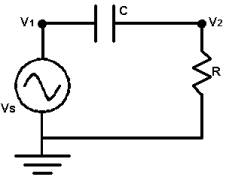POJ 1045:Bode Plot
Bode Plot
| Time Limit: 1000MS | Memory Limit: 10000K | |
| Total Submissions: 13392 | Accepted: 8462 |
Description
Consider the AC circuit below. We will assume that the circuit is in steady-state. Thus, the voltage at nodes 1 and 2 are given by v1 = VS coswt and v2 = VRcos
(wt + q ) where VS is the voltage of the source,w is the frequency (in radians per second),
and t is time. VR is the magnitude of the voltage drop across the resistor, and q is its phase.

You are to write a program to determine VR for different values of w. You will need two laws of electricity to solve this problem. The first is Ohm's Law, which states v2 = iR where i is the current in the circuit, oriented clockwise. The second is i = C d/dt (v1-v2) which relates the current to the voltage on either side of the capacitor. "d/dt"indicates the derivative with respect to t.

You are to write a program to determine VR for different values of w. You will need two laws of electricity to solve this problem. The first is Ohm's Law, which states v2 = iR where i is the current in the circuit, oriented clockwise. The second is i = C d/dt (v1-v2) which relates the current to the voltage on either side of the capacitor. "d/dt"indicates the derivative with respect to t.
Input
The input will consist of one or more lines. The first line contains three real numbers and a non-negative integer. The real numbers are VS, R, and C, in that order. The integer, n, is the number of test cases. The following n lines of the input
will have one real number per line. Each of these numbers is the angular frequency, w.
Output
For each angular frequency in the input you are to output its corresponding VR on a single line. Each VR value output should be rounded to three digits after the decimal point.
Sample Input
1.0 1.0 1.0 9 0.01 0.031623 0.1 0.31623 1.0 3.1623 10.0 31.623 100.0
Sample Output
0.010 0.032 0.100 0.302 0.707 0.953 0.995 1.000 1.000
水题,公式推导。话说真不能再总纠结这水题了,越做越水了现在。
v1 =
VS
v2 =
VRcos (wt + q )
v2 =
iR
C=d/dt (v1-v2)
即(v1-v2)
对t求导
已知Vs,C,R,w,求 VR。因为任意的t,等式都成立,所以对t取特殊值,解方程即可。
代码:
#include <iostream>
#include <cmath>
#include <algorithm>
using namespace std;
int main()
{
double Vs,R,C,w;
int n,i;
cin>>Vs>>R>>C>>n;
for(i=1;i<=n;i++)
{
cin>>w;
printf("%.3f",sqrt(1.0/(1+C*C*w*w*R*R))*C*w*R*Vs);
cout<<endl;
}
return 0;
}版权声明:本文为博主原创文章,未经博主允许不得转载。



